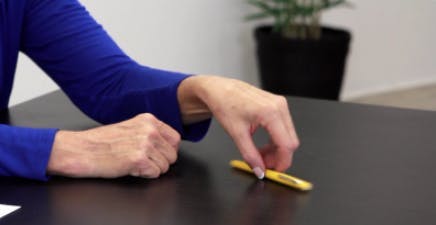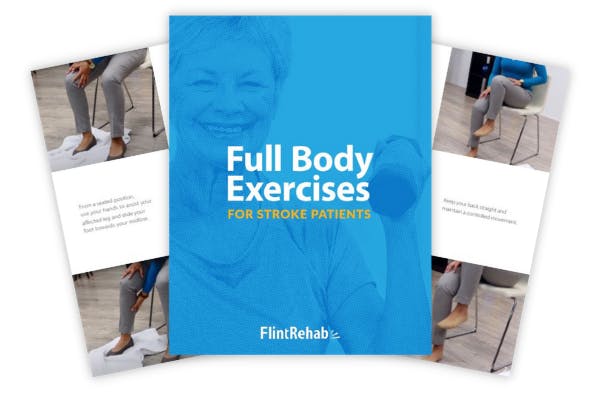
Constraint-Induced Movement Therapy Exercises: How It Works
shop-mgr2023-01-10T12:26:52+08:00When movement on one side of the body is weakened due to neurological injury like stroke, individuals may find it easier to rely on their unaffected side. However, continuous disuse can cause you to lose even more control of your affected side (learned non-use). To improve movement on the affected side, therapists may recommend constraint-induced movement therapy exercises.
To help you understand how constraint-induced movement therapy (CIMT) can be beneficial for recovering movement after neurological injury, this article will discuss how it works and share some exercises you can practice at home.
How Constraint-Induced Movement Therapy Works
To strengthen and improve control over the affected side, it’s essential to practice using it. However, the motivation to move the affected side can be low when individuals struggle with severely limited movement on the affected side.
This is where constraint-induced movement therapy can help. Although it’s a difficult form of therapy, it’s highly effective.
Constraint-induced movement therapy involves 3 steps:
- Restraining use of the unaffected side. This can involve wearing a thick glove or simply keeping the hand behind the back.
- Forcing the use of the affected side. Think “use it or lose it.” The only way to improve a function is to use it.
- Intensive repetition. Consistent stimulation is essential for reinforcing demand in the brain for that function.
By applying these 3 steps, individuals may be able to effectively recover motor control on their affected side.
However, it’s important to note that patients need to have at least some motor control in their affected side to participate in constraint-induced movement therapy. If you are completely paralyzed on your affected side, see our other methods for paralysis recovery.
Up next, we’ll discuss the underlying mechanism that makes CIMT an effective form of treatment.
Why Constraint-Induced Movement Therapy is Effective
Constraint-induced movement therapy is effective because it stimulates the brain and promotes neuroplasticity. Neuroplasticity is the central nervous system’s ability to reorganize itself and make adaptive changes.
Stimulating the brain through consistent, repetitive, and task-specific practice encourages neural rewiring. Therefore, the more you practice, the better the brain gets at perceiving demand for a specific function.
By consistently practicing constraint-induced movement therapy exercises, individuals may gradually develop speed, strength, and more natural movement in their affected side.
In fact, CIMT is considered one of the “most effective treatment regimens in physical therapy” to improve motor function in the weakened arm after stroke.
Now that you understand what CIMT is and why it can be an effective form of therapy for survivors of neurological injury, the following section will share some constraint-induced therapy exercises you can practice at home.
Constraint-Induced Movement Therapy Exercises
Constraint-induced movement therapy is most effective when you gradually increase the difficulty level of the exercises. This helps ensure that you’re being challenged as you improve, which makes the exercises more engaging and allows you to perform more repetitions.
Below are 10 constraint-induced movement therapy exercises. It’s important to pick exercises that make you feel challenged but not overly frustrated. Attempt more difficult exercises as you get stronger.
1. One-Sided Stretches

For a nice warm up, start by placing your affected arm on a cane and lean forward. Do this several times to help stimulate the affected side. While CIMT calls for your non-affected arm to remain behind your back, it’s good to place this arm on top of your affected arm for stability.
2. Straight Push

Place a water bottle on a table, and use your affected arm to glide across the table and tap the water bottle with your fist. You can use your torso to initiate this movement, but pay extra attention to avoid elevating your shoulder.
Even if the movement initiates from the torso, you are paying attention to your affected arm and stimulating it with movement. This attention plays a critical role in activating neuroplasticity and is responsible for some of the therapeutic qualities of constraint-induced movement exercises.
If this exercise feels difficult, rest assured that you are stimulating positive changes in the brain by attempting to do the movement while paying close attention.
3. Play Cards with Your Affected Hand
Place your non-affected arm behind your back to play a card game like solitaire. This is a difficult constraint-induced movement therapy exercise because fine motor skills are often slower to return than arm movement. Only try this exercise if you feel challenged by it but not overly frustrated. Allow yourself plenty of time to pick up and put down cards.
4. Pressing Buttons
Practice pressing buttons with your affected hand. You can use a remote controller to practice adjusting the volume or changing the channels on your television. Another example is to practice pressing the numbers on a microwave.
Again, it can be frustrating to attempt these movements with your non-affected arm behind your back. Remember to breathe and be patient with yourself. The attention paid to your affected side helps promote the therapeutic quality of this constraint-induced movement therapy exercise.
5. Pulling a Zipper
For this exercise, put on a jacket with a zipper, which is an exercise within itself. Then, practice pulling the zipper up and down with your affected hand. This constraint-induced movement therapy exercise will help you practice gripping onto smaller objects while coordinating hand and arm movement together. Even if you only zip half an inch, it’s progress!
6. Hand Exercises

Skim through our hand therapy exercise article and choose some to do with your affected hand only. It may help to place an oven mitt over your non-affected hand to prevent it from getting involved. Start with simple movements like “palm up, palm down” where you flip your hand up and down. When you’re ready for some serious challenge, try spinning a pen with your affected hand (a very complex movement).
7. Turning a Door Knob
Practice opening a door with your affected side. This movement requires strength in your affected hand, depending on the shape of your door knob. As with all constraint-induced movement therapy exercises, do this if it makes you feel challenged but not hopeless. This is a complex motor task and it’s something you can work your way up to if you can’t get it at first.
8. Turning the Pages of a Magazine
Turn the pages of a magazine with your affected hand while avoiding the use of your non-affected hand. If this is too difficult, use your non-affected hand to bend the corners of the magazine pages to make it a little easier to grab.
9. Throwing a Ball
The next two constraint-induced movement exercises are difficult, so attempt them when you feel ready.
Find a ball about the size of a tennis ball or smaller. Then, establish targets so that you have somewhere to aim. Grab the ball with your affected hand and practice throwing it at your targets.
Initially, your targets can be general areas or directions. As your aim improves, try to establish more specific targets to make this CIMT exercise more challenging.
10. Trace Shapes and Handwriting
Draw different shapes on a piece of paper and place it under a piece of glass. Then, use a dry-erase marker to trace the shapes with your non-affected hand. As with all constraint-induced movement therapy exercises, keep your non-affected hand at your side. As you improve, trace more intricate designs such as your signature.
Up next, we’ll discuss how to get the most out of constraint-induced movement therapy exercises.
How to Optimize the Effects of CIMT
To maximize the effects of constraint-induced movement therapy, focus on performing as many repetitions as you can. As mentioned earlier, consistent repetition is necessary to promote adaptive changes in the brain.
In the beginning, you may only be able to perform a few repetitions. What matters is that you keep trying and strive to gradually increase your repetitions over time. Remember, every neurological injury is unique and everyone experiences recovery differently, at their own pace.
Be kind and patient with yourself as you participate in constraint-induced movement therapy. With consistent practice, you may be pleasantly surprised by the improvements in hand function. Best of luck on the road to recovery!
Keep it Going: Get a Free Rehab Exercise Ebook (25 page PDF)

Get our free ebook filled with 25 pages of rehab exercises featuring photos of licensed therapists. Sign up below to get your copy!
When you sign up, you’ll also receive our popular Monday newsletter that contains 5 articles on stroke recovery.
We never sell your email address, and we never spam. That we promise.